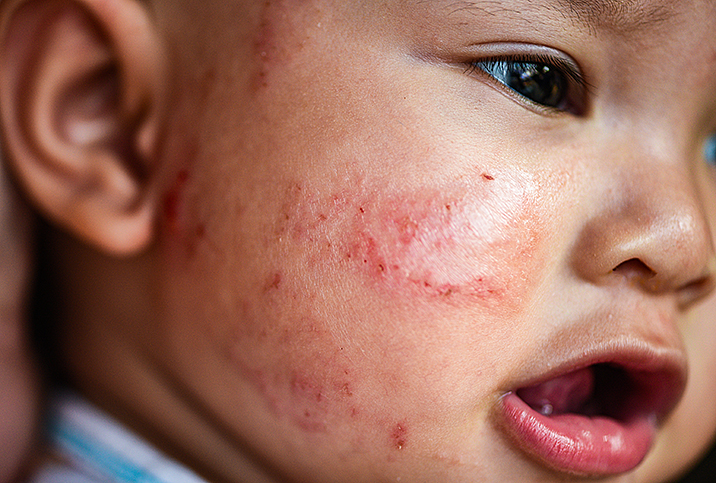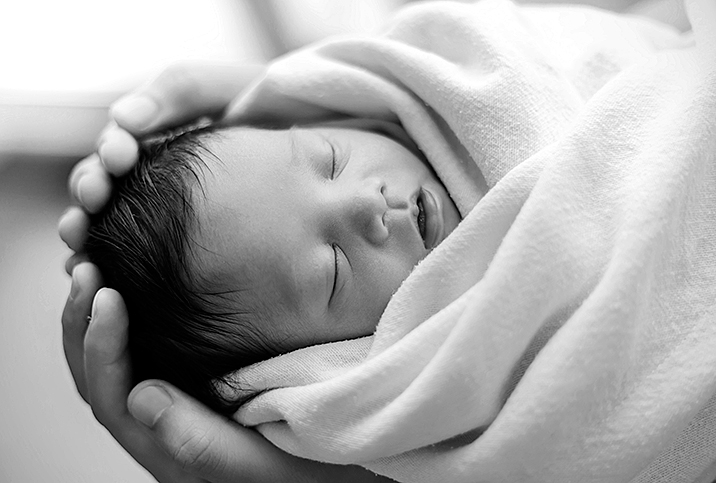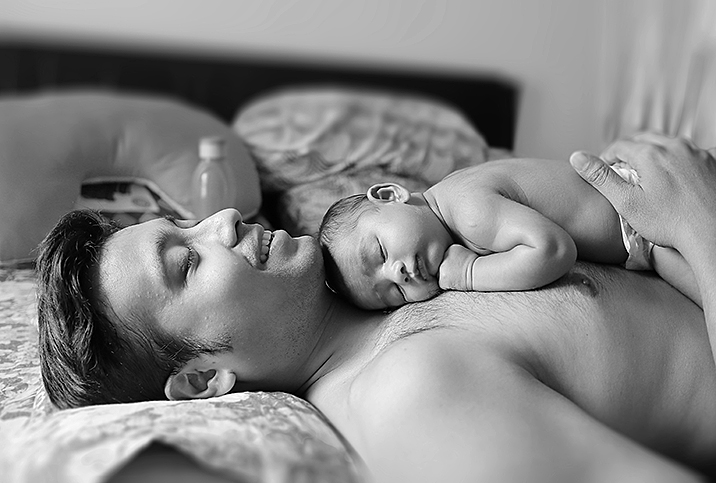Advice From Dermatologists on Common Newborn Skin Problems

Beyond feeding, sleeping and changing, baby skincare is one of the first lessons parents learn. Because newborns often suffer from a variety of minor skin ailments after they are born, it's important parents learn to distinguish between different issues so they know whether the condition is something they can care for at home, or if they need to seek medical attention.
The good news is, many infant skin conditions are temporary and will go away on their own with minimal treatment. We spoke to two dermatologists about common ailments and treatments for your baby's sensitive skin.
The importance of vernix
Infants are born covered in a protective biofilm called vernix. This layer starts to form at 28 weeks gestation and babies are usually covered in it at birth. If a baby is overdue, this barrier may be missing because it has already been fully absorbed into the skin before birth.
Vernix is a thick, white substance with a variety of health benefits for your baby. In addition to providing a useful moisturizing barrier on their skin and regulating body temperature, vernix has antibiotic, antimicrobial and antioxidant properties to help protect your baby against infections and pathogens.
"It is [composed] of water, lipids and proteins with a number of important roles, including hydration of the skin and protection against infection," explained Fiona Worsnop, MBBS, MRCP, a consultant dermatologist at Stratum Dermatology Clinics.
Because of these benefits, the World Health Organization (WHO) recommends delaying a newborn's first bath until 24 hours after birth. Worsnop recommends leaving vernix on for even longer—at least 48 hours—so it can be naturally absorbed into the skin.
Developing a skincare routine for your baby
After the vernix has been absorbed, one of the most common problems you may encounter with your baby's skin is dryness. To keep an infant's delicate skin moisturized—which will also help prevent many other common skin conditions—Worsnop recommends using fragrance-free natural oils, such as coconut oil or sunflower oil, which are safe to use on newborns.
Not only do they moisturize, but they "can improve the barrier function of the skin and help to reduce water loss," Worsnop said.
A newborn's skin may feel rough, but Worsnop stresses it is important not to try and exfoliate it. A baby's skin is delicate and can easily become inflamed or injured.
Her advice is to keep your baby's skincare routine simple in the early days. After their first bath, bathing a baby every four days is sufficient until they are 4 weeks old. After 4 weeks, bathing two to three times a week is often enough, though the diaper area should always be kept as clean as possible.
Applying moisturizer immediately following baths and as often as necessary in between is recommended. Baby powder should not be used.
"The best skincare for a baby are fragrance-free, perfume-free, preservative-free, bland products," Worsnop advised. Even some big baby brands sell products containing harsh chemicals, so always read the label before you buy.
Common skin conditions and how to treat them
In addition to dryness, some of the most common newborn skin problems include baby acne, cradle cap, intertrigo and eczema or dermatitis, said Adam Friedmann, MBBS, a consultant dermatologist with Stratum Dermatology Clinics.
Baby acne
Baby acne is characterized by white or red spots surrounded by reddish skin, especially common on the face. "Some suggest that it is the hormones received from the mother at the end of the pregnancy that cause baby acne," Friedmann explained.
The skin can also be irritated by saliva, milk, fabric detergent or medications taken by the mother or baby. Friedmann said baby acne often clears up within a few weeks on its own, but to wash with warm water and mild soap in the meantime. If it persists for longer than three months, consult with your physician.
Cradle cap
Cradle cap "is a form of seborrhoea that produces yellowish, greasy, flaky scaly patches that develop on a baby's scalp and occasionally the face, ears and neck," Friedmann said.
It is believed to be caused by a mother's hormones and usually clears up on its own after a few weeks or months. Even though it can look very unsightly, the good news is, cradle cap doesn't bother the baby.
Friedmann recommends washing the baby's hair with a mild shampoo and combing with a soft brush. Coconut or rapeseed oil can also help soften the flakes before brushing. It's vital not to pick at these flaky or scaly patches, however tempting it might be. If any of the patches look red or swollen, they might be infected, and you should contact your physician.
Intertrigo
Another condition to keep an eye on is intertrigo, which Friedmann described as a "rash which occurs inside skin folds, such as under the chin of a baby, under the armpit or in the nappy [diaper] area."
Saliva, milk and bath water can collect in the skin folds, which causes redness, weeping or soreness. Intertrigo can be "a combination of mild eczema, fungal infection and irritant dermatitis," Friedmann explained.
Because this irritated skin is missing its top layer, it can become infected with thrush or bacteria. To prevent infection, Friedmann recommends treating it with greasy moisturizers, such as diaper rash cream, using a bib to catch dribbles of milk so they don't land on the skin, and drying the baby thoroughly after a bath. Avoid rubbing the skin and instead pat it dry.
If the condition gets worse, see a physician, who may prescribe a mild antifungal or cortisone. Infant paracetamol can also help if the baby shows signs of discomfort.
Eczema and contact dermatitis
Eczema and contact dermatitis is inflamed skin that can be red, swollen and itchy. "Around 1 in 3 children will have eczema. Usually, this clears up during infancy, but if not, it can be treated by a dermatologist," Friedmann said.
Baby eczema can be managed with the use of a soap substitute and a fragrance-free cream to moisturize the skin and prevent the itchiness, which can disrupt the baby's sleep.
If these solutions don't help, it is essential to see a doctor for advice. They can prescribe a topical corticosteroid cream if the skin is inflamed or help identify an allergen if this is the cause of irritation.
There are several different types of eczema: atopic eczema, allergic contact dermatitis, irritant contact eczema, lichen simplex chronicus and nodular prurigo. For more severe eczema, your doctor may recommend phototherapy (exposure to ultraviolet light or sunlight) or medication.
Other conditions
Babies can inadvertently scratch themselves, so keep their nails trimmed with baby-safe cutters. Using a file can also help. Scratch mittens can stop them from injuring themselves, especially if they wave their hands around in their sleep.
It's important to note that If your baby develops a red rash that is accompanied by other symptoms of being unwell, such as a high temperature or labored breathing, it is essential you take them to the emergency room. This is not a skin condition, but rather could be a sign of a serious illness.
Worsnop stresses the importance of seeing a physician if you have any concerns about your baby's skin or aren't sure how to treat a condition on your own. Using the wrong treatment could also make a dermatological issue worse.
"It is never a good idea to blindly try different treatments if you are not sure what the problem is, as this will not lead to a resolution," Warsnop concluded.
Thankfully for parents, most newborn skin conditions improve on their own if they are treated carefully and consistently.


















